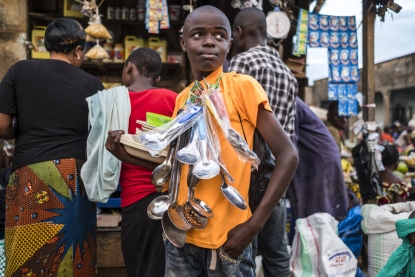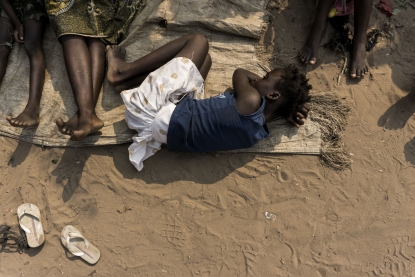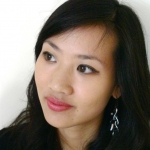First foray in Africa
Lubumbashi, DRC -- I was barely out of the plane when an immigration officer offered to show me on his phone a video of foreigners being beheaded. His colleague next to him proposed to me. It’ll be a while before I forget my arrival in the Democratic Republic of Congo.
After declining both offers as politely as I could, I picked up my luggage and took my first steps in DRC, which was both a personal dream and a professional experience radically different from anything that I had known so far.
 Selling kitchen wares at a market in Beni, November, 2016.
(AFP / Eduardo Soteras)
Selling kitchen wares at a market in Beni, November, 2016.
(AFP / Eduardo Soteras)A French reporter, I have worked in Cambodia, Hong Kong and now New Delhi, where I am the South Asia video coordinator for Agence France-Presse. During the past five years that I have I spent wandering around Asia, I got used to shoving all of my equipment into the back of mad rickshaws speeding in alleys jam-packed with food stalls sending whiffs of citronella or masala into the air. I also got used to sweating profusely under a blinding heat while trying to protect my camera from the monsoon rains.
But this was the first time that I had gone to Africa. This was terra incognita for me. I got the chance to visit the continent in May after I won a fellowship with the International Women’s Media Foundation (IWMF), which sponsors reporting trips to the African Great Lakes region and Latin America for female journalists from across the world. I first went to Kenya, where I spent several days mastering the art of breaking noses, in between two mock kidnappings by overzealous actors armed with real machetes, as part of a hostile environment training for journalists.
Then things got really serious with my arrival in Lubumbashi, in southern DRC, where I spent over a week working on two multimedia stories for AFP, one on the training Academy of the Congolese football club Tout-Puissant Mazembe.
Another on a village of women painters who sell their artworks in France for tens of thousands of dollars.
These stories were very different and allowed me to explore the city as well as the countryside, to talk to teenagers and villagers, to film in a stadium packed with 18,000 people but also in a tiny village deprived of electricity.
Quickly the differences between India and DRC became obvious. I’m of Chinese origin and in France, a lot of people think I am an Asian tourist. In India, people often confuse me for a Nepali. But in Congo, I was simply a “mzungu,” a “white.” For the first time in my life I was as “white” as my blonde and blue-eyed colleagues from the fellowship.
As a video reporter, I am very aware of light and colour, both of which were different in Africa than in Asia. It was absolutely thrilling to work with such a different palette. The Congolese wrappers are as colourful and refined as the Indian sarees. As someone who is used to shooting under the very strong Indian sun, I had to learn how to tame the Congolese light, which was much softer, but also whimsical in its own way.
 This photograph taken on May 13, 2017, shows villagers Josephine Muloba (L) and Prosperine Mwelwa (R) after they painted a hut in Makwatsha, DR Congo.
(AFP / Agnes Bun)
This photograph taken on May 13, 2017, shows villagers Josephine Muloba (L) and Prosperine Mwelwa (R) after they painted a hut in Makwatsha, DR Congo.
(AFP / Agnes Bun)Because I went there during the start of the dry season, enormous clouds kept gliding lazily above the head of my interviewees, constantly changing the light on their face. Filming Congolese skin, which is often darker than Indian skin, is both a fascinating and demanding exercise: the way their face reflects the light is incredible but very unforgiving at the same time, especially if the shot happens to be under-exposed.
 A girl rests with other Internally Displaced Persons (IDP) on a mat ,after falling ill in a camp for IDP's fleeing from the conflict in the Kasai Province on June 4, 2017 in Kikwit. (AFP / John Wessels)
A girl rests with other Internally Displaced Persons (IDP) on a mat ,after falling ill in a camp for IDP's fleeing from the conflict in the Kasai Province on June 4, 2017 in Kikwit. (AFP / John Wessels)Another drastic difference for me was the language. To be able to speak French and work without a fixer or improvised translator was so liberating. I hate shoving my camera under people's faces without exchanging a few words with them beforehand, or at least introducing myself -- a trying task when you don’t speak the language.
In India I am often frustrated to leave with stunning shots of villagers rolling bidis and turban-clad farmers smoking the hookah, without having been able to strike up a real conversation with them. In DRC, I could go to the most isolated neighbourhoods and chat with the children and the elders. It was such a source of joy to be able to do that… And to hear such familiar sounds in such an unfamiliar environment was a new experience.
 Women practice hairdressing at a vocational learning center in Butembo on November 11, 2016.
(AFP / Eduardo Soteras)
Women practice hairdressing at a vocational learning center in Butembo on November 11, 2016.
(AFP / Eduardo Soteras)I also rediscovered the pleasure of walking outside without being stared at, without sweating a litre of water per minute and with fresh air to breathe - a rarity in Delhi, which is the world’s most polluted capital according to the WHO.
In the streets of Lubumbashi, the crowds are less dense, and above all I do not have to fear groping hands, which alas have spoiled the fun of many of my shoots amid the North Indian crowds.
Of course, working in DRC is not a breeze either. On the paperwork front, I found myself on familiar territory: the administration could be as Kafkaesque as in India. We constantly had our pockets stuffed with cigarette packs, just in case we had to grease a few palms - or lungs in that case - at checkpoints.
 Painting a hut in Makwatsha, May 13, 2017. (AFP / Agnes Bun)
Painting a hut in Makwatsha, May 13, 2017. (AFP / Agnes Bun)I also had to face many unexpected developments during my trip: one of my interviewees was convinced my fixer was a spy; we drove past a dead body lying on the ground; policemen beat a man only a few meters away from me, because they suspected him of being a thief; one of the journalists who won the fellowship with me almost got lynched by a hostile crowd near a mine.
The calm of the place looks like it could descend into violence in no time. Talking to a fellow Congolese journalist, I also realised that it was sometimes quite a struggle for local reporters to do their job, especially for women. Next to her, I felt privileged to be able to work daily without having to fear any outside threat.
 This photograph taken on May 13, 2017, shows villager Prosperine Mwelwa painting a hut with a brush in Makwatsha, DR Congo.
(AFP / Agnes Bun)
This photograph taken on May 13, 2017, shows villager Prosperine Mwelwa painting a hut with a brush in Makwatsha, DR Congo.
(AFP / Agnes Bun)Marcel Proust wrote that “the only true voyage of discovery… would be not to visit strange lands but to possess other eyes, to behold the universe through the eyes of another, of a hundred others, to behold the hundred universes that each of them beholds, that each of them is.”
I left DRC with the feeling that I caught a small glimpse of the wonders of this country, through the hundreds of eyes I was fortunate enough to immortalize with my camera and memory.
 A member of the Kimbanguist church submerges himself three times in the holy water to cleanse himself on May 24, 2017 in Nkamba. (AFP / John Wessels)
A member of the Kimbanguist church submerges himself three times in the holy water to cleanse himself on May 24, 2017 in Nkamba. (AFP / John Wessels)



